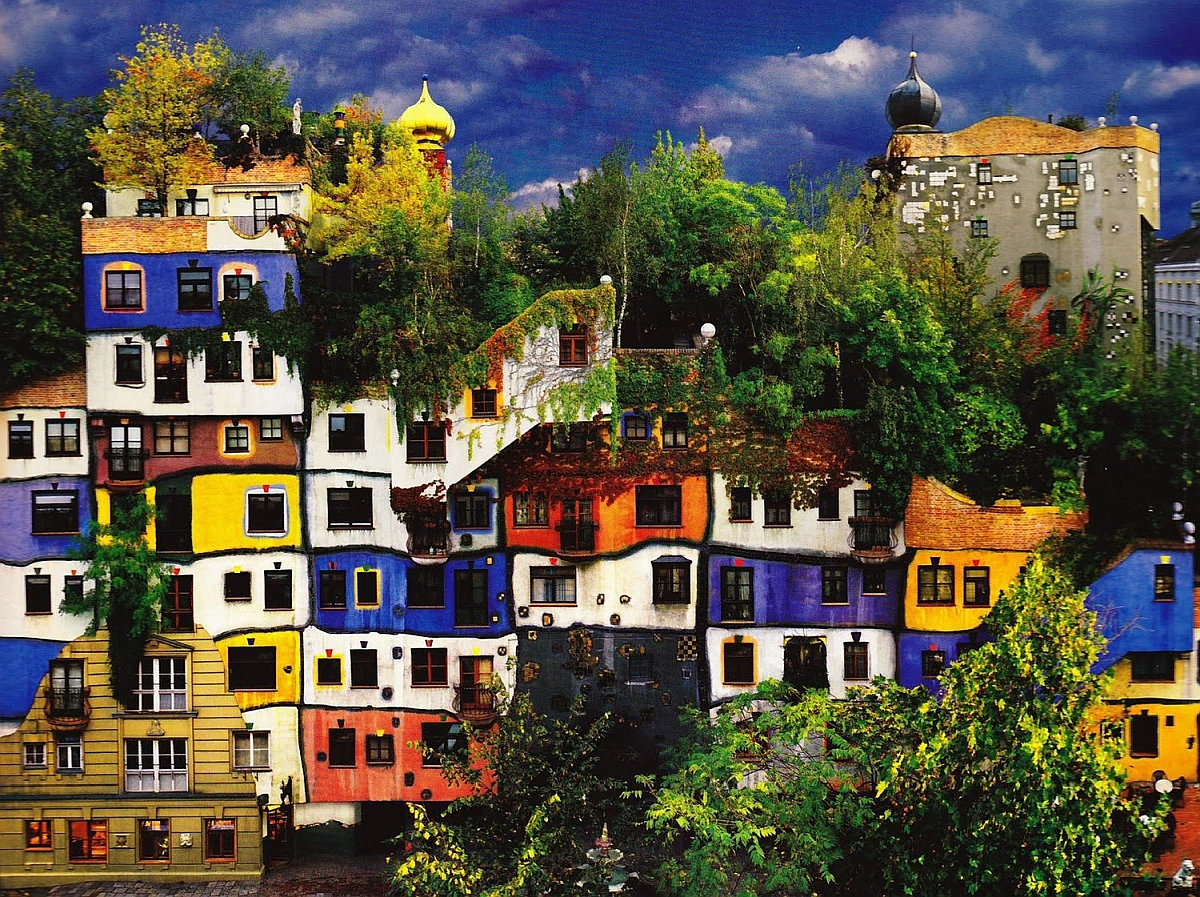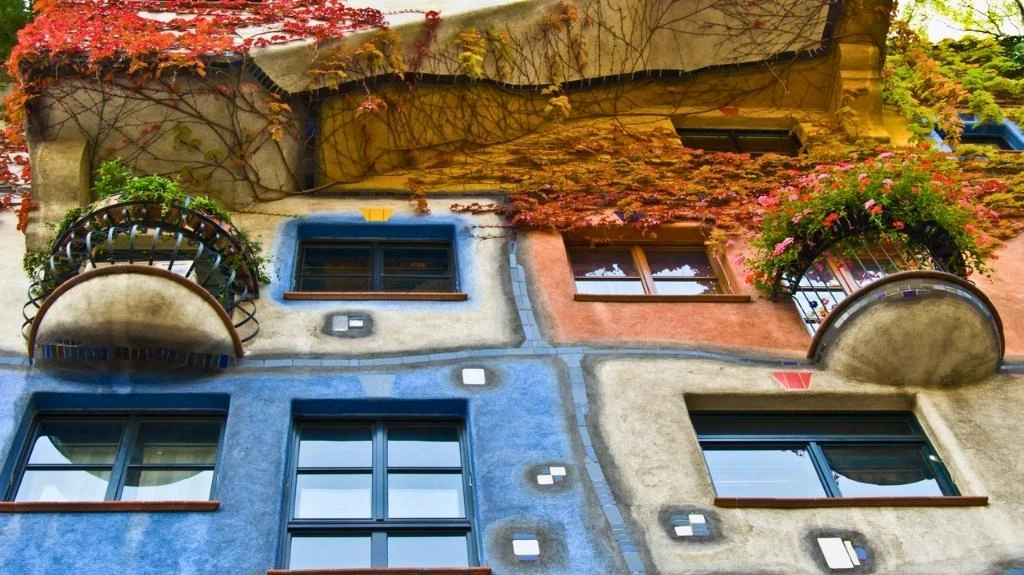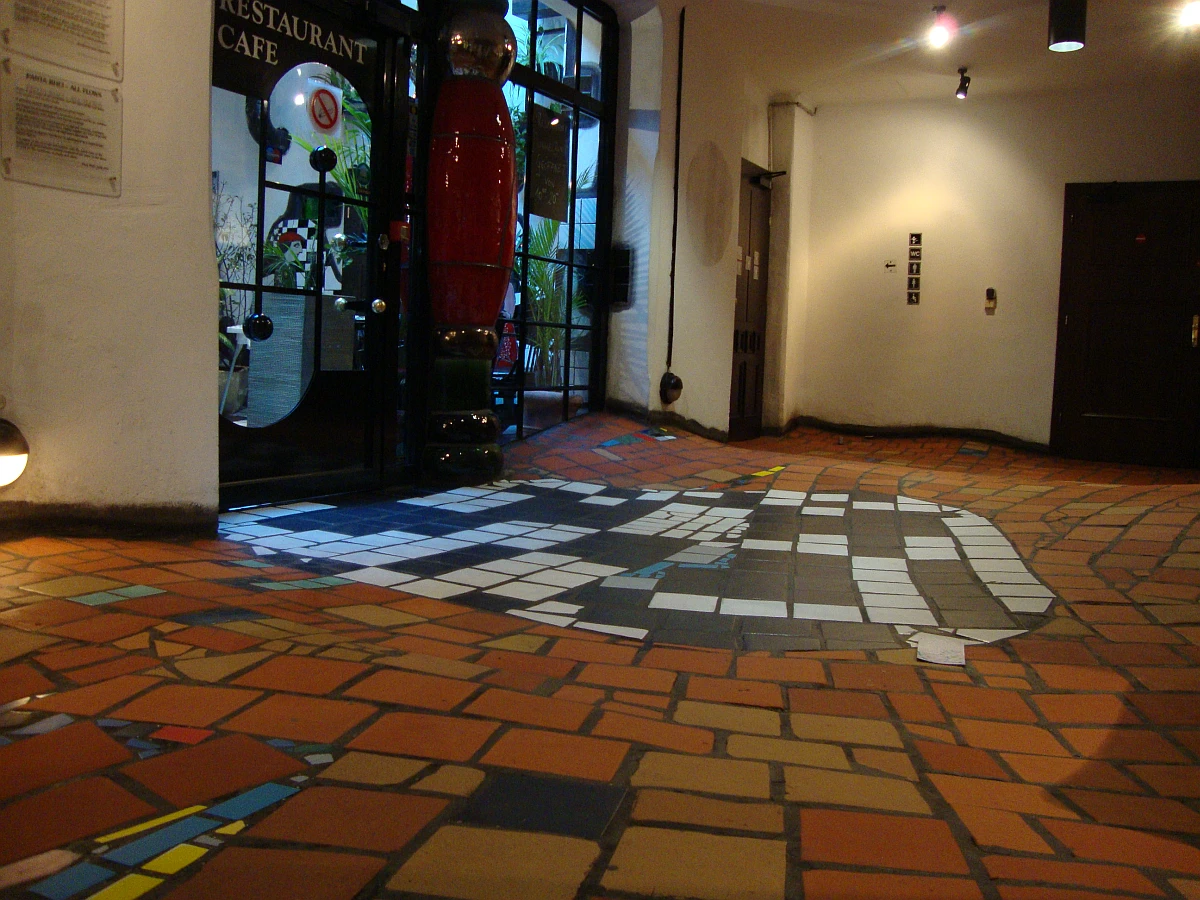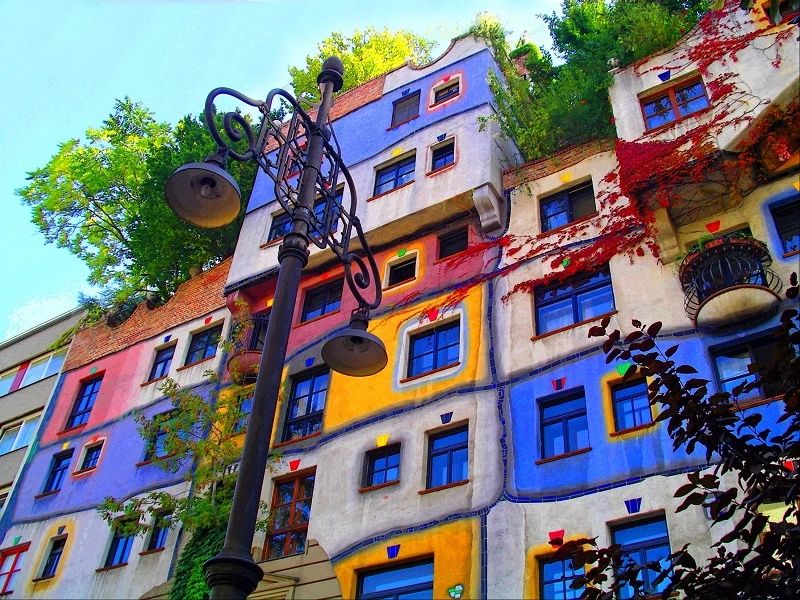Nestled in the heart of Vienna, the Hundertwasser House stands as a testament to the genius of Friedensreich Hundertwasser, a visionary architect who dared to blend art with nature. This iconic building, with its undulating floors, roof planted with trees, and colorful facade, not only challenges conventional architectural norms but also offers a glimpse into a world where humans and nature coexist harmoniously.
Note: This article contains affiliate links. In case you purchase something through one of these links, we may receive a small commission at no extra cost for you. Thank you for helping us keep creating the free content on this website!
Design Philosophy of the Hundertwasser House
The Hundertwasser House, located in the 3rd district of Vienna, stands as a vivid testament to the design philosophy of Friedensreich Hundertwasser, a visionary artist and architect. The house was built between 1983 and 1986 by Joseph Krawina and Peter Pelikan.

It has a new feature of undulating, uneven floors, a roof covered with grass and earth, and large trees growing out of the rooms, their branches sprouting from the windows. Hundertwasser did not accept payment for the design of the house, because he thought it was worth it just to not have something ugly built in its place.
Inside the house are 52 apartments, 4 offices, 16 private and 3 communal terraces, and a total of 250 trees and shrubs. The Hundertwasser House is one of the most visited buildings in Vienna and has been declared part of Austria's cultural heritage.
This iconic building breaks away from the rigidity of conventional architecture to embrace a more organic, human-centric approach. Hundertwasser's design philosophy was deeply rooted in harmony with nature, a principle vividly reflected in the Hundertwasser House. He believed that human beings are intrinsically tied to the natural world and that our living spaces should celebrate rather than suppress this connection. This philosophy guided the creation of the Hundertwasser House, making it a landmark that defies traditional architectural norms with its undulating floors, irregularly placed windows, and lush rooftop gardens.
The Hundertwasser House is not merely an architectural marvel but a symbol of environmental consciousness and individual creativity. Hundertwasser advocated for "window rights", a concept that allowed residents to decorate the exteriors around their windows as they pleased, fostering a sense of ownership and personal expression.
This idea is a direct challenge to the uniformity and anonymity often found in urban housing. Furthermore, the building's integration of natural elements, such as trees growing from inside rooms and out through windows, blurs the line between the built environment and the natural world. This deliberate intertwining of nature and architecture underlines Hundertwasser's commitment to ecological sustainability and his rejection of the sterile, geometric forms dominating urban landscapes.
Through its existence, the Hundertwasser House challenges us to reimagine our relationship with our living spaces, urging us toward a future where buildings not only shelter us but also inspire and connect us to the natural world. This architectural gem thus continues to attract visitors from around the globe, eager to experience the realization of Hundertwasser's visionary ideals.
The Architect: Friedensreich Hundertwasser
Friedensreich Hundertwasser, born Friedrich Stowasser in 1928, was an Austrian-New Zealand artist and architect who left an indelible mark on the world of art and architecture with his unique and ecological approach. Hundertwasser's architectural philosophy was deeply rooted in harmony with nature, advocating for a life that integrates human beings, their buildings, and the environment into a single, sustainable system. His disdain for straight lines and the "grid" system prevalent in urban planning led him to create buildings that were as whimsical and vibrant as his paintings.
One of the most iconic examples of his architectural genius is the Hundertwasser House in Vienna. This residential building, completed in 1985, stands as a testament to Hundertwasser's vision of a more human and environmentally friendly approach to architecture. The Hundertwasser House defies conventional architectural norms with its undulating floors, a rooftop covered in earth and grass, and large trees growing from inside the rooms, with limbs extending from windows. The building's facade is a kaleidoscope of colors, with mosaic tiles, irregularly shaped windows, and varied materials that break the monotony of urban landscapes.

Hundertwasser's work was not just about aesthetics; it was a radical call to rethink our relationship with our living spaces and the environment. The Hundertwasser House, with its emphasis on natural elements within urban settings, exemplifies his belief in the importance of ecological balance. It has become a pilgrimage site for those interested in alternative architecture and ecological living, illustrating Hundertwasser's enduring influence on sustainable design philosophies.
Beyond the Hundertwasser House, his architectural legacy includes various remarkable projects such as the KunstHausWien, another building in Vienna that houses a permanent collection of his work, and the Maishima Incineration Plant in Osaka, Japan, which features his signature colorful and organic forms. Hundertwasser's commitment to environmental sustainability, his rejection of the straight line, and his advocacy for individual creativity within architecture have cemented his status as a visionary architect. His works continue to inspire architects and environmentalists worldwide, proving that buildings can, indeed, be both functional and a form of natural art.
Architectural Features
From the moment one lays eyes on the building, it's clear that this is no ordinary structure. The facade is a lively canvas of colorful tiles, mosaics, and layers of vegetation that seem to cascade over the balconies and windows, injecting life into the urban environment. This choice of materials and designs not only beautifies the space but also contributes to the building's eco-friendly features, such as the rooftop garden. This garden is not just an aesthetic delight but a functional space that absorbs rainwater, reducing runoff and aiding in temperature regulation.
Inside, Hundertwasser House continues to challenge conventional architecture. The floors are intentionally uneven, designed to mimic the natural irregularity of terrain, a concept that encourages residents and visitors to be more mindful of their movements and their connection to the earth. This feature is a hallmark of Hundertwasser's architectural philosophy, which emphasizes harmony between humanity and nature. The building's design encourages a symbiotic relationship with the environment, promoting sustainable living practices in an urban setting.
Hundertwasser House stands as a bold declaration against the monotony of traditional urban architecture. Its design elements, from the rooftop garden to the irregular floors and the vibrant facade, all serve a dual purpose of functionality and beauty. They not only challenge the occupants to rethink their relationship with their living spaces but also inspire other architects and city planners to consider more ecological and aesthetically enriching designs in urban developments. In doing so, Hundertwasser House remains a symbol of innovative architecture that harmonizes with nature, proving that buildings can be both functional and a source of inspiration in the urban landscape.
The Uneven Floor
"The flat floor is an invention of the architects. It fits engines - not human beings. People not only have eyes to enjoy the beauty they see and ears to hear melodies and noses to smell nice scents. People also have a sense of touch in their hands and feet.
If modern man is forced to walk on flat asphalt and concrete floors as they were planned thoughtlessely in designers' offices, estranged from man's age-old relationship and contact to earth, a crucial part of man withers and dies. This has catastrophic consequences for the soul, the equilibrium, the well being and the health of man. Man forgets how to experience things and becomes emotionally ill.

An uneven and animated floor is the recovery of man’s mental equilibrium,of the dignity of man which has been violated in our levelling, unnatural and hostile urban grid system.
The uneven floor becomes a symphony, a melody for the feet and brings back natural vibrations to man.
Architecture should elevate and not subdue man. It is good to walk on uneven floors and regain our human balance."
Hundertwasser, April, 1991
Cultural Impact of the Hundertwasser House
Since its completion, the Hundertwasser House in Vienna has emerged as a significant cultural landmark, captivating visitors from all corners of the globe. Designed by Friedensreich Hundertwasser, this unique building defies traditional architectural norms with its vibrant colors, organic forms, and integration of natural elements, making it a masterpiece of ecological architecture. Its distinctiveness not only draws tourists but also serves as a vivid reminder of the possibilities that emerge when architects dare to envision beyond conventional boundaries.
The cultural impact of the Hundertwasser House extends far beyond its immediate visual appeal. It has challenged architects and designers to reconsider the role of nature in urban environments, advocating for a harmonious coexistence between human habitation and the natural world. This philosophy has inspired a new generation of buildings that prioritize green spaces, sustainability, and individuality, marking a departure from the impersonal and industrialized structures that have dominated urban landscapes. The Hundertwasser House stands as a testament to the idea that buildings can serve as both functional living spaces and works of art, encouraging a more thoughtful approach to architecture that values creativity and ecological sensitivity.
Moreover, the Hundertwasser House's influence can be seen in the broader cultural movement towards environmental consciousness and sustainable living. It represents a pioneering example of how buildings can contribute to environmental stewardship through innovative design elements such as tree tenants (trees growing from within the rooms), rooftop gardens, and the use of natural materials.
In doing so, it has not only shaped the aesthetic sensibilities of architects but has also played a pivotal role in promoting sustainable practices in the construction industry. The legacy of the Hundertwasser House continues to inspire, demonstrating the enduring power of architecture to challenge, enchant, and influence societal values towards a more sustainable and aesthetically enriched world.
Visiting Hundertwasser House
Those wishing to explore the interior of this unique building might find themselves at a bit of a standstill, as the Hundertwasser House can only be viewed from outside. This policy preserves the privacy and tranquility of its residents, ensuring that the essence of Hundertwasser's vision for a living space in tune with natural elements remains undisturbed.

Right opposite the Hundertwasser House, however, lies the Hundertwasser Village. This place offers a glimpse into the world of Hundertwasser's architectural and artistic genius. Open to visitors, the Hundertwasser Village is not just an architectural site but a vibrant community space that houses shops, cafes, and galleries.
It serves as a portal through which the public can engage with Hundertwasser's ideas and aesthetics in a more immersive way. The contrast between the exclusive Hundertwasser House and the welcoming Hundertwasser Village underscores a unique balance between private sanctuary and public engagement, reflecting Hundertwasser's nuanced approach to community, architecture, and the environment.
Visitors to Vienna are thus presented with a fascinating dichotomy: the Hundertwasser House captivates from the outside with its unparalleled design and the promise of an alternative way of living and building, while the Hundertwasser Village offers an inside look at the practical application of these ideals. Together, they provide a comprehensive insight into Hundertwasser's visionary world, making them must-visit destinations for those interested in architecture that breaks the mold.
FAQs about Hundertwasser House
What is Hundertwasser House and where is it located?
Hundertwasser House is a unique and colorful apartment building situated in Vienna, Austria. Designed by the Austrian artist Friedensreich Hundertwasser, this architectural marvel stands out for its vibrant colors, organic forms, and incorporation of natural elements into its structure. It was completed in 1985 and has since become one of Vienna's most popular tourist attractions.
What makes Hundertwasser House unique?
The building's design breaks away from conventional architectural norms by featuring uneven floors, a lack of straight lines, and the extensive use of vibrant colors. Hundertwasser's philosophy was deeply rooted in harmony with nature, which is evident in the building's green roof, tree tenants (trees that grow from within rooms, through the windows, and out onto the roof), and the integration of plants throughout the structure. It's a testament to the possibility of living in harmony with nature within an urban environment.
Can visitors tour the inside of Hundertwasser House?
While the exterior of the building and its courtyard are accessible to the public, the apartments themselves are private residences and are not open for tours. However, visitors can explore the nearby KunstHausWien, a museum also designed by Hundertwasser, which houses a permanent exhibition of his work and philosophy, including architectural models and designs.
How does Hundertwasser House contribute to environmental sustainability?
Hundertwasser was an early advocate for environmental sustainability, and this is reflected in the design of the building. The use of green roofs helps to reduce urban heat, improve air quality, and promote biodiversity. The building also utilizes natural light effectively, and the integration of plants and trees contributes to the building's natural cooling, reducing the need for air conditioning.
Are there any other buildings designed by Hundertwasser?
Yes, Friedensreich Hundertwasser has designed several other buildings and structures that reflect his unique style and environmental philosophy. Notable examples include the KunstHausWien in Vienna, the Waldspirale apartment complex in Darmstadt, Germany, and the Hundertwasser Toilets in Kawakawa, New Zealand. Each building features his signature use of vibrant colors, organic forms, and ecological principles, making them distinctive landmarks in their respective locations.
Site location: Kegelgasse 36-38, 1030 Wien
GPS coordinates: 48.207698, 16.394194
Google Photos: Click here
Did you find our article interesting? We have good news, as we will be constantly updating the content on our website. If you want to know all about Europe's big cities, follow our column by clicking here!















